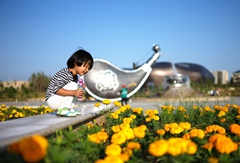A green village rises from barren desert
Updated: 2017-09-07  Print
Print 




Children play at the entrance to Wudeng Qaidam village.

Villagers check the leaves of a tree.

Wudeng Qaidam village has become an oasis.
Wudeng Qiadam village in Ordos’ Ejin Horo Banner, home to about 1,000 villagers, lies at the edge of the Maowusu Desert, yet it is one of the model inspection sites of the 13th Session of the Conference of the Parties to the UNCCD.
The village boasts verdant plants and fresh air which can hardly be found elsewhere in the arid regions of Northwest China.
All the villagers give a thumbs up to village Party secretary Li Hua and his father Li Mingliang, the former village leader. In the 1970s, the village suffered serious desertification and its vegetation rate was about 8 percent. The houses, yards and production and living facilities often got buried or damaged in gale weather and 60 percent of the villagers chose to resettle.
Faced with that harsh reality, Li Mingliang led the villagers in planting trees for nearly 20 years, which not only contributed to combating desertification, but also improved the living conditions and environment of the local residents. The village was named as a "China Top 1,000 Afforestation Village" in the 1990s.
In 2000, Li Hua succeeded his father's post and mission. "The forest coverage rate had already reached 45 percent in my father's generation and we are supposed to carry on their efforts and try to turn clean water and green hills into gold and silver mountains," he said.
Since 2000, Ejin Horo Banner has mobilized the masses and endeavored to prevent and control desertification. Li Hua implemented public awareness and education activities about grazing prohibitions and fire prevention, which were the top priorities of all work, and actively advocated afforestation. He encouraged the villagers to plant more trees on barren lands in spring and autumn, resulting in a 30 percent increase in the forest coverage rate.
Li Hua also helped introduce salix mongolica (a form of willow) processing enterprises to buy the villagers’ trees. From 2000 to 2008, the per capita net income of the forest and sand industry in his village rose to 1,000 yuan ($152.70) per year. The villagers vigorously advanced the forest and sand industry and paved a win-win path of ecological construction and industrial development.
Many villagers working elsewhere have come back in response to the heartening changes. In 2013, Bai Wenxiu, a 64-year-old local villager, insisted on returning to the village after retirement. “I think I can enjoy my retirement in the beautiful environment and fresh air,” Bai said.
At the beginning of this year, the village Party branch forged a partnership with Inner Mongolia Qingyan Salix Mongolica Industry Engineering Technology Center Co and enlarged the scale of the forest and sand industry. Li Hua plans to plant sylvestris and willows in less afforested areas.
Wudeng Qaidam village is no longer what it used to be: the forest coverage rate has gone up to 75 percent and its forest and grass coverage rate now stands at 95 percent.





 Ordos Impression
Ordos Impression Ordos WeChat
Ordos WeChat Ordos Reported
Ordos Reported


